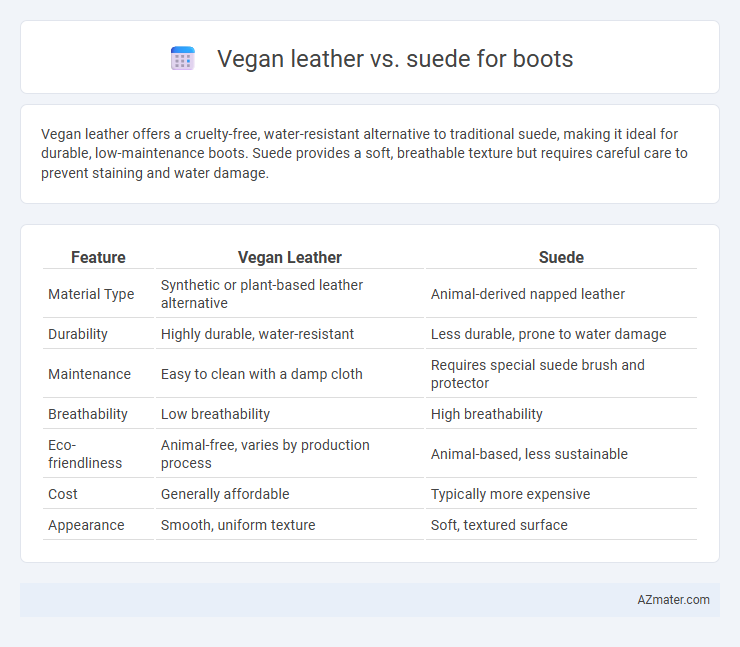Vegan leather offers a cruelty-free, water-resistant alternative to traditional suede, making it ideal for durable, low-maintenance boots. Suede provides a soft, breathable texture but requires careful care to prevent staining and water damage.
Table of Comparison
| Feature | Vegan Leather | Suede |
|---|---|---|
| Material Type | Synthetic or plant-based leather alternative | Animal-derived napped leather |
| Durability | Highly durable, water-resistant | Less durable, prone to water damage |
| Maintenance | Easy to clean with a damp cloth | Requires special suede brush and protector |
| Breathability | Low breathability | High breathability |
| Eco-friendliness | Animal-free, varies by production process | Animal-based, less sustainable |
| Cost | Generally affordable | Typically more expensive |
| Appearance | Smooth, uniform texture | Soft, textured surface |
Introduction: Vegan Leather vs Suede for Boots
Vegan leather offers a cruelty-free alternative to traditional suede, crafted from synthetic or plant-based materials that mimic the texture and durability of animal hide. Suede, derived from the underside of animal leather, provides a soft, luxurious feel but requires more maintenance and is less resistant to water and stains. Choosing between vegan leather and suede for boots involves weighing ethical considerations, environmental impact, and practical performance.
Material Origins and Production Processes
Vegan leather is derived from synthetic materials like polyurethane or natural sources such as cork and pineapple fibers, produced through environmentally-conscious processes that minimize animal exploitation and reduce resource consumption. Suede, traditionally made from the underside of animal hides, involves a labor-intensive tanning and finishing process that uses chemicals impacting environment and animal welfare. The contrast between plant-based or synthetic origins in vegan leather and animal-derived origins in suede highlights significant differences in sustainability, ethical considerations, and production technologies.
Texture and Visual Appeal
Vegan leather offers a smooth, consistent texture with a sleek, polished finish that mimics traditional leather, making it visually appealing for modern, cruelty-free fashion. Suede boasts a soft, napped surface with a matte appearance, delivering a rich, tactile depth ideal for luxurious, vintage-inspired boots. The choice between vegan leather and suede hinges on desired texture--vegan leather's durability contrasts with suede's delicate, velvety feel--and the intended aesthetic, where vegan leather suits contemporary styles and suede enhances classic elegance.
Comfort and Breathability
Vegan leather boots offer a smooth texture and water-resistant properties but generally lack breathability compared to suede, which provides superior air circulation and moisture absorption, enhancing overall comfort. Suede's natural fibers make it softer and more adaptable to foot contours, promoting a more comfortable fit over extended wear. Choosing between vegan leather and suede depends on prioritizing durability and ease of maintenance versus enhanced breathability and natural comfort.
Durability and Longevity
Vegan leather boots offer superior durability against water and stains compared to traditional suede, making them ideal for long-term wear in various weather conditions. Suede, made from animal hide, tends to absorb moisture and can wear down faster with constant exposure to rough environments, limiting its longevity. High-quality vegan leather materials maintain structural integrity and appearance over time, providing a sustainable and durable alternative to suede for boot manufacturing.
Water Resistance and Weather Suitability
Vegan leather boots offer superior water resistance compared to suede, making them ideal for wet or rainy conditions due to their non-porous surface. Suede, characterized by its soft and porous texture, absorbs moisture easily, leading to potential damage and reduced durability in damp environments. When selecting footwear for varying weather, vegan leather provides better protection and longevity in wet climates, whereas suede requires careful maintenance and is better suited for dry weather.
Eco-Friendliness and Sustainability Impact
Vegan leather, typically made from polyurethane or plant-based materials like pineapple leaves or apple waste, offers a more sustainable alternative to traditional animal-derived suede by reducing reliance on livestock farming and lowering greenhouse gas emissions. Suede, derived from animal hides, involves intensive water usage, chemical treatments, and ethical concerns related to animal welfare, contributing to environmental degradation. Choosing vegan leather boots supports eco-friendliness through lower resource consumption and biodegradability potential, making it a preferred option for sustainable fashion.
Maintenance and Care Requirements
Vegan leather boots require minimal maintenance, needing only regular wiping with a damp cloth and occasional application of a protective spray to prevent cracking and staining. Suede boots demand more intensive care, including frequent brushing with a suede brush to remove dirt and restore texture, as well as the use of specialized suede protectors to guard against water damage and stains. Proper storage in a cool, dry place and avoiding prolonged exposure to moisture are crucial for extending the lifespan of both vegan leather and suede footwear.
Price and Market Availability
Vegan leather boots are generally more affordable than suede, with prices ranging from $40 to $150 depending on brand and quality, while suede boots typically start at $100 and can exceed $300. Vegan leather enjoys widespread market availability, found in popular retail stores and online platforms, appealing to eco-conscious consumers seeking cruelty-free options. Suede boots have a strong presence in premium and designer markets but are less common in budget-friendly outlets due to higher production costs and material care requirements.
Style Versatility and Trend Comparisons
Vegan leather boots offer a sleek, modern aesthetic with a smooth texture that complements both casual and formal outfits, making them highly versatile for diverse style preferences. Suede boots provide a softer, matte finish renowned for adding a luxurious, vintage appeal to ensembles, particularly favored in fall and winter fashion trends. Current trends show vegan leather gaining popularity due to ethical fashion movements, while suede maintains classic appeal, making both materials valuable depending on the desired style statement.

Infographic: Vegan leather vs Suede for Boot
 azmater.com
azmater.com